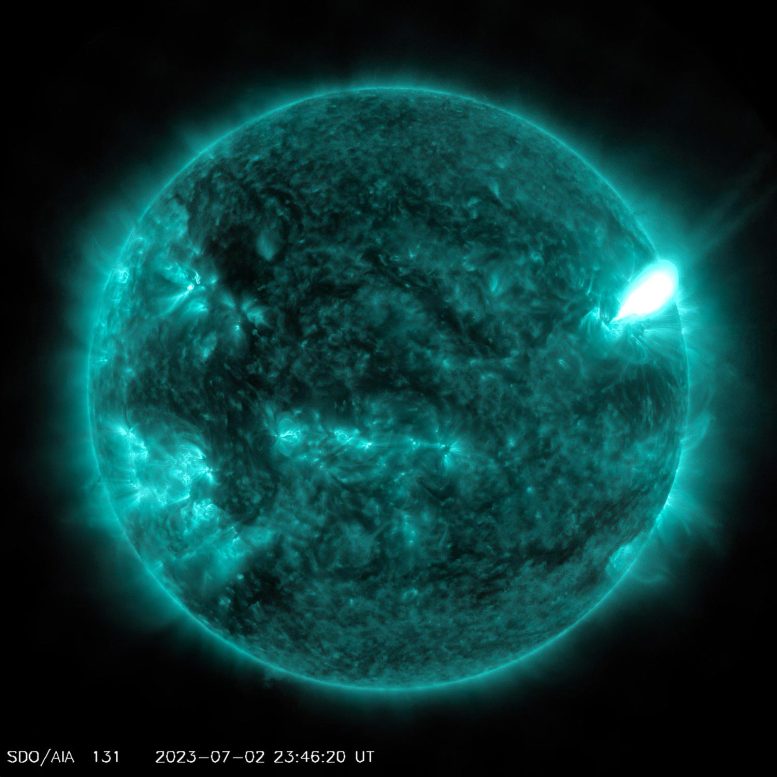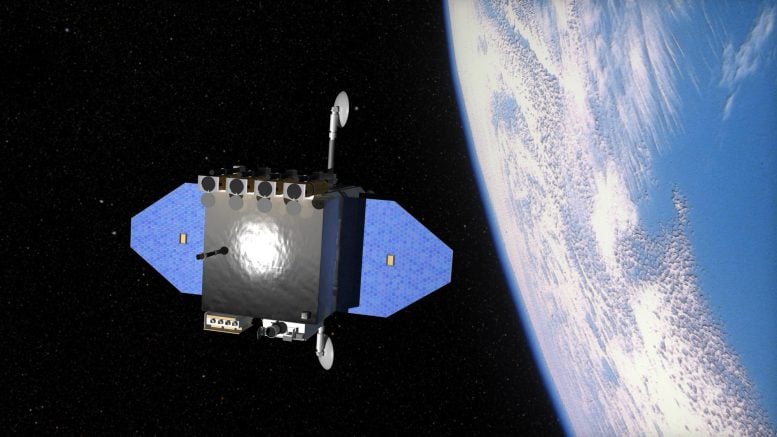
NASA’s Solar Dynamics Observatory captured this image of a solar flare – as seen in the bright flash on the top right area of the Sun – on July 2, 2023. The image shows a subset of extreme ultraviolet light that highlights the extremely hot material in flares and which is colorized in teal. Credit: NASA/SDO
The Sun emitted a strong solar flare, peaking at 7:14 p.m. EDT (4:14 p.m. PDT) on July 2, 2023. NASA’s Solar Dynamics Observatory, which watches the Sun constantly, captured an image of the event.
This flare is classified as an X1.0 flare. X-class denotes the most intense flares, while the number provides more information about its strength.
A solar flare is a sudden and significant release of energy in the Sun’s atmosphere, often associated with sunspots and magnetic activity. These flares are the largest explosive events in our solar system, ejecting bundles of charged particles and electromagnetic radiation into space.
Solar flares are primarily observed through the light they emit across multiple wavelengths, ranging from radio waves to gamma rays. The classification of a solar flare’s intensity generally involves measurements of the X-ray flux in the 1 to 8 angstrom range, detected from satellites in Earth’s orbit. The most commonly used system categorizes them into A, B, C, M, or X classes, with A-class being the smallest and X-class the largest. Within each class, a numerical scale from 1 to 9 further indicates strength (with the exception of X-class flares, which can go beyond 9).

NASA’s Solar Dynamics Observatory (SDO), launched in February 2010, is a mission designed to study the causes of solar variability and its impacts on Earth. The goal is to help us understand how the Sun’s magnetic field is generated and structured, and how this stored magnetic energy is converted and released into the heliosphere and geospace in the form of solar wind, energetic particles, and variations in the solar irradiance. (Artist’s concept image of the SDO satellite orbiting Earth.) Credit: NASA
Solar flares can have a range of effects on Earth. The most immediate impact is on our planet’s ionosphere, where the flare’s radiation can cause a sudden ionospheric disturbance (SID), disrupting high-frequency (HF) radio communications. More severe flares, particularly X-class, can result in radio blackouts that last for a few minutes to a few hours.
The charged particles associated with solar flares, especially when accompanied by coronal mass ejections (CMEs), can also pose a threat to both satellites and astronauts in space due to increased radiation levels. Over time, this can degrade satellite electronics and pose a health hazard to astronauts.
Additionally, when these charged particles reach Earth’s magnetic field, they can cause geomagnetic storms. These storms can result in beautiful auroras, but they can also disrupt power grids, potentially causing widespread blackouts. In fact, the largest recorded geomagnetic storm, the Carrington Event in 1859, resulted from a powerful solar flare and caused telegraph systems across Europe and North America to fail, with some reports of operators receiving electric shocks and telegraph pylons throwing sparks.
Furthermore, solar flares can have effects on Earth’s climate, although this is still an area of ongoing research. Some scientists suggest that prolonged periods of high solar flare activity could have a slight warming effect on Earth’s climate, while periods of low activity could have a slight cooling effect.









Also, the flair must be facing the Earth for it to be a potential problem.
That is Gods disapppointment towards what is being done here.
Why can’t we build something to put in between the earth and the sun that would soak up a suns solar flare and turn it into energy that the can send back to earth that the can use to power a ton of things for us back on earth and also save us from the solar flare bucaus it will be soaked up to send back to earth to power it